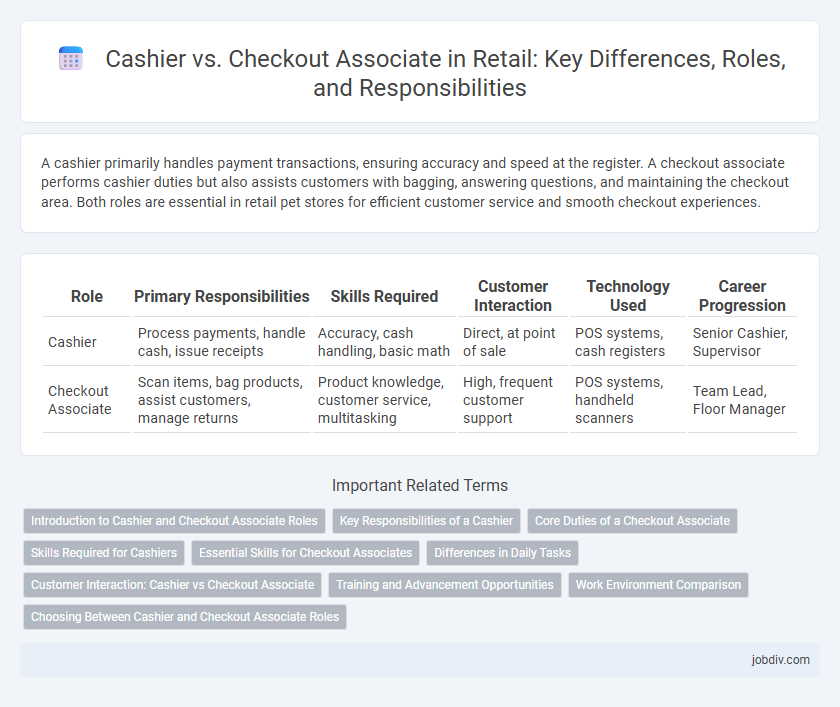A cashier primarily handles payment transactions, ensuring accuracy and speed at the register. A checkout associate performs cashier duties but also assists customers with bagging, answering questions, and maintaining the checkout area. Both roles are essential in retail pet stores for efficient customer service and smooth checkout experiences.
Table of Comparison
| Role | Primary Responsibilities | Skills Required | Customer Interaction | Technology Used | Career Progression |
|---|---|---|---|---|---|
| Cashier | Process payments, handle cash, issue receipts | Accuracy, cash handling, basic math | Direct, at point of sale | POS systems, cash registers | Senior Cashier, Supervisor |
| Checkout Associate | Scan items, bag products, assist customers, manage returns | Product knowledge, customer service, multitasking | High, frequent customer support | POS systems, handheld scanners | Team Lead, Floor Manager |
Introduction to Cashier and Checkout Associate Roles
Cashier and Checkout Associate roles are essential positions in retail environments focused on processing customer transactions efficiently and accurately. Cashiers primarily handle payment processing, including cash, credit, and mobile payments, while Checkout Associates often perform additional duties such as bagging items, assisting customers with product inquiries, and maintaining the checkout area's cleanliness. Both roles require strong customer service skills, attention to detail, and the ability to work quickly in a fast-paced setting.
Key Responsibilities of a Cashier
Cashiers handle accurate transaction processing, manage cash registers, and provide customers with receipts promptly. They verify prices, scan items efficiently, and ensure the correct handling of payments including cash, credit, and digital wallets. Customer service excellence and inventory awareness are essential to support smooth checkout operations and resolve any pricing or product queries swiftly.
Core Duties of a Checkout Associate
A Checkout Associate primarily scans and processes customer purchases efficiently, ensuring accuracy in pricing and payment handling. They manage the checkout area by bagging items, issuing receipts, and maintaining cleanliness and organization to enhance the customer experience. Unlike cashiers who focus solely on transactions, Checkout Associates often assist with customer inquiries and resolve minor issues at the point of sale.
Skills Required for Cashiers
Cashiers require strong numerical aptitude, attention to detail, and excellent customer service skills to handle transactions accurately and efficiently. Proficiency in operating point-of-sale (POS) systems and cash registers is essential, alongside the ability to manage cash, credit, and digital payments securely. Effective communication and problem-solving abilities ensure smooth checkout experiences and address customer inquiries promptly.
Essential Skills for Checkout Associates
Checkout Associates must excel in customer service, possess strong cash handling abilities, and demonstrate proficiency with point-of-sale (POS) systems to ensure efficient transaction processing. Attention to detail and quick problem-solving skills are critical for accurately scanning items, managing returns, and addressing customer inquiries. Effective communication and teamwork capabilities enhance overall store operations and contribute to a positive shopping experience.
Differences in Daily Tasks
Cashiers primarily handle scanning items, processing payments, and issuing receipts to customers, ensuring accurate transaction completion. Checkout associates perform broader duties including restocking shelves, assisting customers with inquiries, bagging groceries, and maintaining checkout lane cleanliness. The key difference lies in checkout associates engaging in multitasking beyond payment processing to enhance customer service and store operations.
Customer Interaction: Cashier vs Checkout Associate
Checkout Associates engage more actively with customers by answering questions and assisting with product locations, enhancing the overall shopping experience. Cashiers primarily focus on scanning items and processing payments efficiently, ensuring quick transaction times. Both roles require strong communication skills but differ in the depth of customer interaction and support provided during the purchase process.
Training and Advancement Opportunities
Cashiers typically undergo basic training focused on point-of-sale systems and customer interaction, enabling quick onboarding for immediate productivity. Checkout Associates receive more comprehensive training that includes inventory management, product knowledge, and customer service skills, preparing them for advanced roles within the retail environment. Advancement opportunities for Checkout Associates often lead to positions in store management or specialized departments, while Cashiers commonly transition into these roles after acquiring additional experience and training.
Work Environment Comparison
Cashiers primarily work at fixed registers in retail stores, handling transactions, scanning items, and processing payments in a stationary environment. Checkout Associates often have a more flexible work setting, which may include managing self-checkout stations, assisting customers with returns, and restocking nearby shelves. Both roles require strong customer service skills, but Checkout Associates may encounter a broader range of tasks and dynamic work areas within the store.
Choosing Between Cashier and Checkout Associate Roles
Choosing between cashier and checkout associate roles depends on the scope of responsibilities and customer interaction. Cashiers primarily focus on processing transactions efficiently, while checkout associates often assist with bagging, customer inquiries, and maintaining the checkout area. Retail candidates should assess their preference for transactional tasks versus broader customer service engagement when deciding which position aligns best with their skills.
Cashier vs Checkout Associate Infographic

 jobdiv.com
jobdiv.com